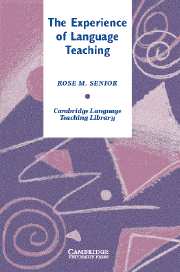Book contents
- Frontmatter
- Contents
- List of figures
- Acknowledgements
- Preface
- Introduction
- 1 Establishing a framework for the book
- 2 Training to be a language teacher
- 3 Becoming a committed language teacher
- 4 Establishing the learning environment
- 5 The diversity of the language classroom
- 6 Managing individuals
- 7 Teaching flexibly
- 8 Vitalising the language class
- 9 Maintaining the classroom community
- 10 Frustrations and rewards
- 11 What drives language teachers
- 12 Towards a teacher-generated theory of classroom practice
- References
- Index
1 - Establishing a framework for the book
Published online by Cambridge University Press: 05 November 2012
- Frontmatter
- Contents
- List of figures
- Acknowledgements
- Preface
- Introduction
- 1 Establishing a framework for the book
- 2 Training to be a language teacher
- 3 Becoming a committed language teacher
- 4 Establishing the learning environment
- 5 The diversity of the language classroom
- 6 Managing individuals
- 7 Teaching flexibly
- 8 Vitalising the language class
- 9 Maintaining the classroom community
- 10 Frustrations and rewards
- 11 What drives language teachers
- 12 Towards a teacher-generated theory of classroom practice
- References
- Index
Summary
This chapter describes the steps that were taken to identify a suitable framework for the book. Section 1.1 describes why a qualitative research approach was selected to examine classroom processes, and why it was decided to conduct the first of the five interlinked studies upon which the book is based as a grounded theory study. Section 1.2 describes the data collection and analysis procedures that are an integral part of grounded theory development, and that must be followed in the prescribed way if a grounded theory is eventually to emerge. Section 1.3 describes the framework that was identified on the completion of the first study. This framework, taken from the discipline of social psychology, enabled a wide range of classroom behaviours to be collected – and their interrelationships explored.
Selecting the research approach
Which path to follow: qualitative or quantitative?
An important decision faced by any person embarking on any kind of research project is what kind of research approach to adopt. The researcher first needs to decide whether to conduct research that is towards either the qualitative or the quantitative end of the research spectrum: research that aims to describe or explain a particular phenomenon, or research that aims to investigate hypotheses and to present findings in numerical terms. A range of both practical and psychological factors influences the decision of the researcher. Practical considerations include access to suitable locations for the research, availability of willing informants, and time constraints.
- Type
- Chapter
- Information
- The Experience of Language Teaching , pp. 14 - 35Publisher: Cambridge University PressPrint publication year: 2006



